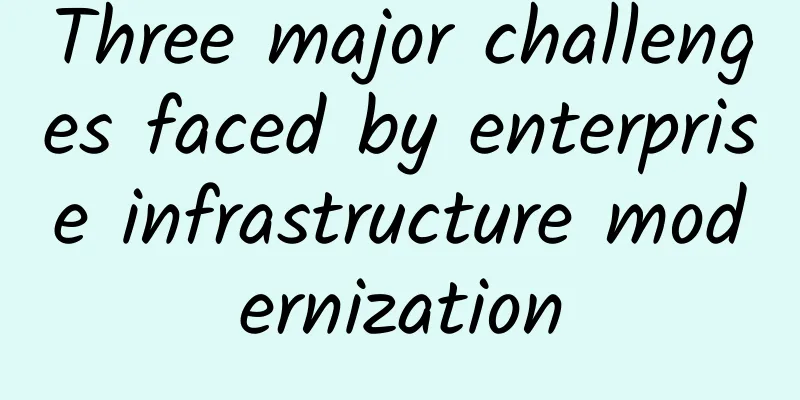Three major challenges faced by enterprise infrastructure modernization

|
Currently, business development often leads to a rapid increase in data volume, resulting in higher demands for data backup and recovery. However, most companies now use traditional IT architecture that scales upward, and are constantly facing new challenges in infrastructure integration, management, and expansion.
According to the survey, most enterprises do not realize that 70% of their data exists on secondary storage; 49% of the enterprises surveyed said that RTO/RPO targets are the biggest challenge they face; 44% of the enterprises surveyed solve the problem of insufficient storage capacity by adding disks. For most enterprises, an increase in data volume means an increase in secondary storage. However, secondary storage will occupy a large amount of IT resources, and the overall efficiency is difficult to meet business objectives. At the same time, the IT architecture with multiple data management solutions will create data islands and greatly increase the complexity of the IT environment. Therefore, most companies face the following three challenges. Infrastructure Integration Challenges The secondary storage products currently on the market are relatively complex, and the implementation process will consume a lot of manpower and time for enterprises. At the same time, the deployment of multiple different solutions will inevitably create data silos, which will hinder the visibility, effective management and portable migration of all data. Ultimately, enterprises face a variety of pain points such as heavy workload for operation and maintenance personnel, high hardware costs, time-consuming data migration, insufficient use of IT resources, and lack of data insights. Infrastructure Management Challenges Traditional IT infrastructure management usually faces pain points such as too many manual processes, time-consuming system integration, vendor lock-in that makes replacement difficult, and difficulty in migrating data to different storage tiers. As a result, enterprises face problems such as difficulty in achieving SLA targets, waste of human resources, high hardware costs, and difficulty in hardware upgrades. Infrastructure Scaling Challenges When enterprises expand their infrastructure, they often find that the infrastructure is inflexible, difficult to expand, difficult to meet service level requirements, difficult to predict the performance and cost of the expanded architecture, and difficult to achieve RTO and RPO targets. These will directly affect the ability of enterprises to meet business needs, meet data compliance requirements, and provide data insights for the business, ultimately affecting the overall digitalization process of the enterprise. To avoid the above three challenges, enterprises must build a new platform that is predictable, highly simplified and integrated. |
>>: Five firewall configuration mistakes to avoid
Recommend
HostXen offers a 50 RMB bonus for every 300 RMB you spend during Double 11, and a 150 RMB bonus for every 600 RMB you spend. 2G packages for Japan/Hong Kong start from 70 RMB, and new customers will receive coupons
HostXen's Double 11 event actually started on...
The battle for power saving in 5G mobile phones
As of the end of 2020, 718,000 5G base stations h...
Why are operators so "overwhelmed" by frequent and large-scale network failures?
Telecom's recent situation is a bit like &quo...
The Matter protocol is rising rapidly. Do you really understand it?
The topic we are going to talk about today is rel...
PacificRack: $7.99/year KVM-768MB/13GB/1TB/Los Angeles data center
PacificRack started selling the new Virtualizor p...
Slow Wi-Fi? Want to make it 4 times faster? Try these tips!
In the modern Internet era, the highest productiv...
A brief discussion on the organizational structure design of data center operation and maintenance
A data center is a complex organization with many...
V5.NET adds Hong Kong Huawei Cloud dedicated line independent server monthly payment of HK$385, physical server/cloud server first order 30% off
The tribe has shared information about V5.NET sev...
GINERNET: €19.95/year - 1GB/10G NVMe/1TB/Spain VPS
Is there anyone who needs a Spanish VPS? GINERNET...
Linode: Free $100 for new users, cloud servers in 11 data centers starting at $5/month
Linode is a VPS cloud hosting company that has be...
The first in the industry! China Network Security and China Merchants Group signed a comprehensive network information security service contract
In order to actively respond to the national stra...
NASA thinks the moon will soon have its own internet
It's been nearly 50 years since astronauts la...
How DevOps is shaping the future of networking
Since its advent in 2009, the DevOps philosophy h...
my country has already achieved commercial use of 5G, with leading technology and scale, but it is difficult to fully popularize it due to three problems
The most frequently heard topic in the past two y...









